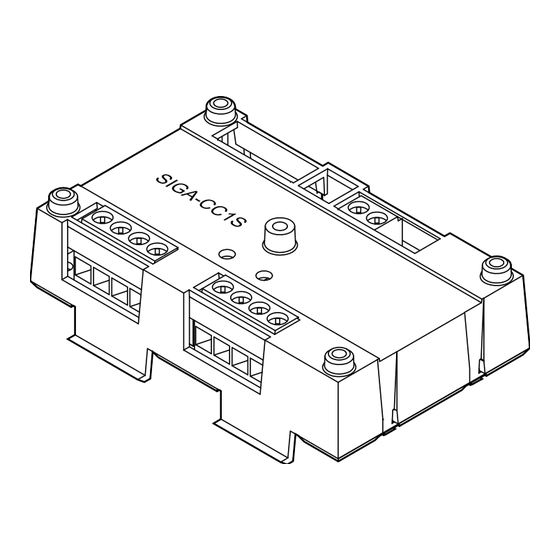
Table of Contents
Advertisement
Quick Links
SIGA-CC1S Auto-Sync Output Module
Installation Sheet
Description
The SIGA-CC1S Auto-Sync Output Module is an addressable
module that is used to connect the following circuits:
•
Audible and visible notification appliance circuits
(synchronized or unsynchronized)
•
Speaker circuits
•
Two-way telephone communication circuits (three-state or
four-state)
Upon command from the loop controller, the module connects
the riser to the output circuit.
The module requires one address on the signaling line circuit
(SLC). Addresses are assigned electronically. There are no
address switches.
Diagnostic LEDs provide visible indication of the state of the
module through the cover plate:
•
Normal: Green LED flashes
•
Alarm/active: Red LED flashes
Personality codes
Use the personality codes described below to configure the
SIGA-CC1S module. See Table 1 for listing information.
© 2017 United Technologies Corporation
Table 1: Personality codes
Code
Description
5
Signal - supervised
output (Class B)
6
Telephone - three-state
(Class B)
25
Signal – supervised auto
sync output (Class B)
26
Telephone - four-state
(Class B)
Signal - supervised output (Class B).
Personality code 5:
Configures the SIGA-CC1S module as a riser selector for
audible and visible notification appliance circuits or for
single-channel audio circuits. The output circuit is monitored for
open or shorted wiring. If a short exists, the module will not
activate in order to prevent shorting the riser. The module will
activate once the short is cleared.
6: Telephone - three-state (Class B).
Personality code
Configures the module as a riser selector for a three-state
firefighter's telephone. When a telephone handset is plugged
into its jack or lifted from its hook, the module generates its
own ring-tone signal, making a separate ring-tone riser
unnecessary. The module sends this signal to the control panel
to indicate the presence of an off-hook condition, and waits for
the system operator to respond to the call. When the system
operator responds, the ring-tone signal is disabled.
Personality code 25:
(Class B). Factory default. Configures the module to provide
synchronization of compatible fire alarm signals across multiple
zones. Operation is the same as Personality code 5 with the
addition that the module provides a sync signal for connecting
synchronized temporal horn/strobes.
The use of nonsynchronous fire alarm signals with or
Note:
instead of compatible synchronized fire alarm signals does not
comply with UL 1971.
Personality code 26:
Configures the module as a riser selector for a four-state
firefighter telephone. Operation is the same as Personality
code 6 except that the module can distinguish when a
telephone is off-hook and when the circuit is shorted, which
causes a trouble condition.
1 / 6
UL 864
CAN/ULC-
S527
Signal - supervised auto sync output
Telephone - four-state (Class B).
P/N 3100152-EN • REV 11 • ISS 16MAR17
EN 54-18
Advertisement
Table of Contents

Summary of Contents for Edwards SIGA-CC1S
- Page 1 (Class B) Signal - supervised output (Class B). Personality code 5: Configures the SIGA-CC1S module as a riser selector for audible and visible notification appliance circuits or for single-channel audio circuits. The output circuit is monitored for open or shorted wiring. If a short exists, the module will not activate in order to prevent shorting the riser.
- Page 2 Figure 1: Installing the SIGA-CC1S module • Test resistors are supplied with the SIGA-CC1S to prevent trouble signals on unused circuits during installation. When connecting field wires, remove the test resistors and install a UL/ULC Listed 47 kΩ EOLR at the end of the circuit.
- Page 3 Figure 3: Wiring diagram for NAC (personality code 5 and 25) (1)(2)(3)(4) (10) (3)(8) (1) Signal polarity is shown when the circuit in supervisory state. (4) For synchronized signals you must use synchronized temporal Polarity reverses when the circuit is active. horn/strobes and personality code 25.
- Page 4 Figure 4: Wiring diagram for audio (personality code 5) (1)(2)(3)(4) (10) (1) Signal polarity is shown when the circuit in supervisory state. (4) Unshielded twisted pair. Polarity reverses when the circuit is active. (5) 47 kΩ EOLR (P/N EOL-47). (2) Supervised. (6) Signaling line circuit (SLC) to next device.
- Page 5 Refer to the NFPA 70 National Electrical Code for more details. (4) Required if distance from the SIGA-CC1S to the phone is greater than 5 ft. Shield must be continuous, insulated, and isolated from ground, except for the connection to chassis (10) ground in the control panel.
- Page 6 Specifications Regulatory information Operating voltage range 15.20 to 19.95 VDC FCC compliance This device complies with part 15 of the FCC Rules. Operation is subject to the following two Current conditions: (1) This device may not cause Standby 310 µA harmful interference, and (2) this device must Activated 150 µA...

Need help?
Do you have a question about the SIGA-CC1S and is the answer not in the manual?
Questions and answers
What is the torque when tightening the wire harness here? It's not included in the instruction manual.